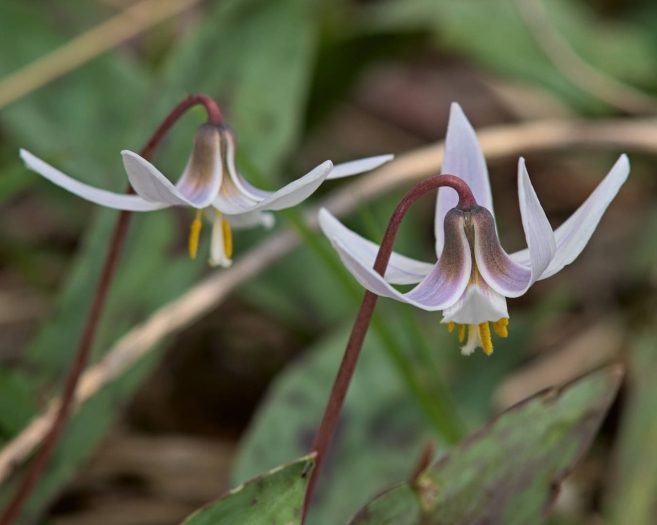White Fawnlily
(Erythronium albidum)
White Fawnlily (Erythronium albidum)
/
/

Douglas Douven
CC BY 4.0
Image By:
Douglas Douven
Recorded By:
Copyright:
CC BY 4.0
Copyright Notice:
Photo by: Douglas Douven | License Type: CC BY 4.0 | License URL: http://creativecommons.org/licenses/by/4.0/ | Rights Holder: Douglas Douven | Publisher: iNaturalist | Date Created: 2021-04-24T14:11:32-07:00 |



















































Estimated Native Range
Summary
Erythronium albidum, commonly known as White Fawnlily, is a deciduous perennial herb native to rich, moist woodlands and floodplains in the Central and Southern United States, as well as Ontario, Canada. It typically grows to a height of 0.5-1 feet (15-30 cm) and a width of 0.3-0.5 feet (9-15 cm). The plant features mottled basal leaves and produces nodding, bell-shaped white flowers with a yellow center in early to mid-spring. The flowers are quite showy and are often highlighted by the contrasting purplish-brown markings on the leaves.
White Fawnlily is valued for its delicate appearance and is often used in woodland gardens, shade gardens, and naturalized areas. It is a low-maintenance plant that adds early spring interest before the canopy of deciduous trees fully leafs out. While it prefers moist, well-drained soils rich in organic matter, it is relatively adaptable and can tolerate drier conditions once established. It is best grown in part shade to full shade and requires consistent moisture during the growing season. White Fawnlily is not commonly affected by serious pests or diseases, but it can be sensitive to overly dry or waterlogged soils. It is not known for being invasive and tends to naturalize gently by self-seeding when conditions are favorable.CC BY-SA 4.0
White Fawnlily is valued for its delicate appearance and is often used in woodland gardens, shade gardens, and naturalized areas. It is a low-maintenance plant that adds early spring interest before the canopy of deciduous trees fully leafs out. While it prefers moist, well-drained soils rich in organic matter, it is relatively adaptable and can tolerate drier conditions once established. It is best grown in part shade to full shade and requires consistent moisture during the growing season. White Fawnlily is not commonly affected by serious pests or diseases, but it can be sensitive to overly dry or waterlogged soils. It is not known for being invasive and tends to naturalize gently by self-seeding when conditions are favorable.CC BY-SA 4.0
Plant Description
- Plant Type: Herb
- Height: 0.5-1 feet
- Width: 0.3-0.5 feet
- Growth Rate: Moderate
- Flower Color: White
- Flowering Season: Spring
- Leaf Retention: Deciduous
Growth Requirements
- Sun: Part Shade, Full Shade
- Water: Medium
- Drainage: Slow, Medium
Common Uses
Bee Garden, Bird Garden, Butterfly Garden, Edible*Disclaimer: Easyscape's listed plant edibility is for informational use. Always verify the safety and proper identification of any plant before consumption., Hummingbird Garden
Natural Habitat
Rich, moist woodlands and floodplains
Other Names
Common Names: Small White Fawn Lily, White Adder’s-Tongue, White Dog’s-Tooth Violet, Serpent’s Tongue, Trout Lily, Deer Tongue, White Trout Lily, Érythrone Blanchâtre, Small White Fawnlily
Scientific Names: , Erythronium albidum, Erythronium albidum var. coloratum, Erythronium albidum var. albidum,
GBIF Accepted Name: Erythronium albidum Nutt.